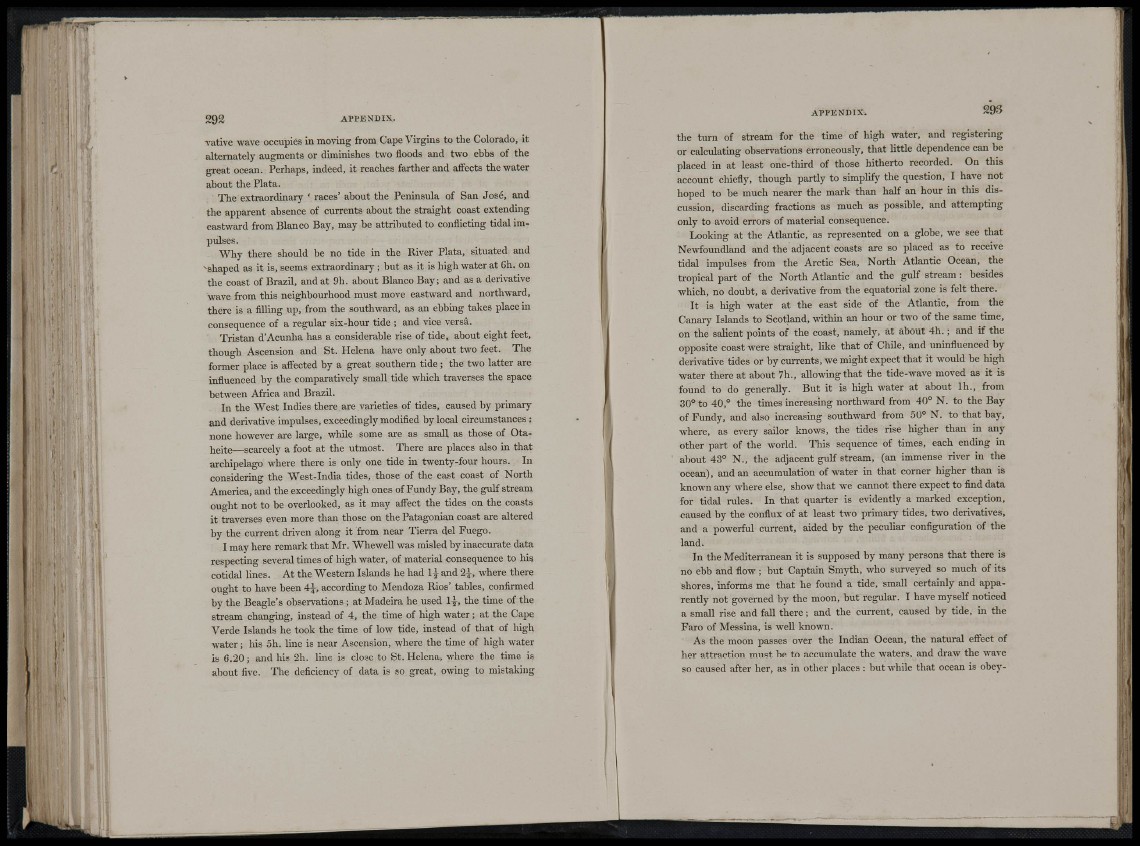
- f f T "
!
9 rii
h m
i' I
m n
f -
i:^ H
2 9 2 AP PENDIX.
vative wave occupies in moving from Cape Virgins to the Colorado, it
alternately augments or diminishes two floods and two ebbs of the
great ocean. Perhaps, indeed, it reaches farther and affects the water
about the Plata.
The extraordinary ' races' about the Peninsula of San José, and
the apparent absence of currents about the straight coast extending
eastward from Blanco Bay, may be attributed to conflicting tidal impulses.
Why there should be no tide in the River Plata, situated and
"shaped as it is, seems extraordinary ; but as it is high water at Gh. on
the coast of Brazil, and at 9h. about Blanco Bay; and as a derivative
wave from this neighbourhood must move eastward and northward,
there is a filling up, from the southward, as an ebbing talces place in
consequence of a regular six-hour tide ; and vice versa.
Tristan d'Acunha has a considerable rise of tide, about eight feet,
though Ascension and St. Helena have only about two feet. The
former place is affected by a great southern tide ; the two latter are
influenced by the comparatively small tide which traverses the space
between Africa and Brazil.
In the West Indies there are varieties of tides, caused by primary
and derivative impulses, exceedingly modified by local circumstances :
none however are large, while some are as small as those of Otaheite—
scarcely a foot at the utmost. There are places also in that
archipelago where there is only one tide in twenty-four hours. In
considering the West-India tides, those of the east coast of North
America, and the exceedingly high ones of Fundy Bay, the gulf stream
ought not to be overlooked, as it may affect the tides on the coasts
it traverses even more than those on the Patagonian coast are altered
by the current driven along it from near Tierra del Fuego.
I may here remark that Mr. Whewell was misled by inaccurate data
respecting several times of high water, of material consequence to his
cotidal lines. At the Western Islands he had I J and where there
ought to have been 4}, according to Mendoza Rios' tables, confirmed
by the Beagle's observations ; at Madeira he used 1^, the time of the
stream changing, instead of 4, the time of high water ; at the Cape
Verde Islands he took the time of low tide, instead of that of high
water ; his 5h. line is near Ascension, where the time of high water
is 6.20 ; and his 2h. line is close to St. Helena, where the time is
about five. The deficiency of data is so great, owing to mistaking
APPENDIX. S93
the turn of stream for the time of high water, and registering
or calculating observations erroneously, that little dependence can be
placed in at least one-third of those hitherto recorded. On this
account chiefly, though partly to simplify the question, I have not
hoped to be much nearer the mark than half an hour in this discussion,
discarding fractions as much as possible, and attempting
only to avoid errors of material consequence.
Looking at the Atlantic, as represented on a globe, we see that
Newfoundland and the adjacent coasts are so placed as to receive
tidal impulses from the Arctic Sea, North Atlantic Ocean, the
tropical part of the North Atlantic and the gulf stream : besides
which, no doubt, a derivative from the equatorial zone is felt there.
It is high water at the east side of the Atlantic, from the
Canary Islands to Scotland, withm an hour or two of the same time,
on the salient points of the coast, namely, at about 4h. ; and if the
opposite coast were straight, hke that of Chile, and uninfluenced by
derivative tides or by currents, we might expect that it would be high
water there at about 7h., allowing that the tide-wave moved as it is
found to do generally. But it is high water at about Ih., from
30° to 40,° the times increasing northward from 40° N. to the Bay
of Fundy, and also increasing southward from 50° N. to that bay,
where, as every sailor knows, the tides rise higher than in any
other part of the world. Tliis sequence of times, each ending in
about 43° N., the adjacent gulf stream, (an immense river in the
ocean), and an accumulation of water in that comer higher than is
known any where else, show that we cannot there expect to flnd data
for tidal rules. In that quarter is evidently a marked exception,
caused by the conflux of at least two primary tides, two derivatives,
and a powerful current, aided by the peculiar configuration of the
land.
In the Mediterranean it is supposed by many persons that there is
no ebb and flow ; but Captain Smyth, who surveyed so much of its
shores, informs me that he found a tide, small certainly and apparently
not governed by the moon, hut regular. I have myself noticed
a small rise and faU there ; and the current, caused by tide, in the
Faro of Messina, is well known.
As the moon passes over the Indian Ocean, the natural eflfect of
her attraction must be to accumulate the waters, and draw the wave
so caused after her, as in other places : but while that ocean is obey